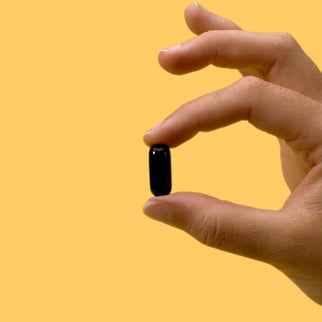Between TV commercials and self-promoting food labels, we are constantly told about many of the essential vitamins and nutrients we should receive daily. However, there are various nutrients that we hear about less but are still very important for our general health.
Omega-3 is one example of a nutrient that is more important for your health than you might realize, and it is important that you are mindful about receiving enough of it before your body starts to tell you what you’re missing. If you are concerned that you do not receive enough omega-3 fatty acids in your daily diet, you should look out for a few signs.
What Is Omega-3?

Omega-3 fatty acids are polyunsaturated fatty acids that make up the foundations of many cells in our bodies.
The body uses three main types of omega-3 fatty acids: alpha-linolenic acid (ALA), which is an omega-3 precursor, eicosapentaenoic acid (EPA), and docosahexaenoic acid (DHA). The two most important of the three, EPA and DHA, are both long-chain fatty acids that offer the most benefits for systems in the body.
ALA acts as a precursor to DHA and EPA, as it is used by the body to create these two fatty acids. Although, the body does not create large amounts of DHA and EPA from ALA alone since it has very low conversion rates. In men, only about 8% of ALA is converted into EPA, while between just 0 and 4% is converted to DHA. In women, these rates are a bit higher, as about 21% of ALA is converted to EPA and approximately 9% to DHA.
Although there are many more dietary sources of ALA, the intake of ALA through diet is rarely enough to provide your body with the long-chain omega-3 fatty acids it needs. Therefore, it is vital that DHA and EPA omega-3s are a key part of your daily intake, either through diet or supplementation, to avoid a deficiency.
What Are the Benefits of Omega-3?
For example, DHA is found in the brain and eyes as it makes the foundation of many cells. EPA, on the other hand, plays a different role, as it produces eicosanoids, which help provide balance for many bodily systems.
These two vital fatty acids provide the following benefits:
- Support heart health
- Support healthy fetal development
- Support brain development during childhood
- Maintain healthy cholesterol levels already within the healthy range
- Support emotional wellness
- Aid in circulation
- Support joint health
- Maintain eye health
- Support energy levels
How Can I Tell If I Might Have an Omega-3 Deficiency?

Despite the importance that omega-3 fatty acids have in the body, not everyone obtains the necessary amounts through their diet. Research has shown that over 60% of adults and 95% of children may not consume enough omega-3s in their diet.
The recommended daily intake for DHA and EPA is 500 mg daily for the general healthy adult population. This amount of DHA and EPA can help support heart health and overall wellness.
If you do not ingest this amount daily, you may start to experience some of the signs of omega-3 deficiency. Here are a few of the most common symptoms associated with a shortage of omega-3s:
1. Fatigue
Omega-3 fatty acids are a crucial source of energy within the body. Without an adequate supply of these essential nutrients, the side effects are likely to be noticeable. Omega-3s assist in the breakdown of fats and sugars that provide calories of energy for the body. This energy is then used to support a wide range of bodily functions, from muscle movement to cell repair.
Another important role of omega-3 fatty acids is their contribution to sleep regulation. DHA helps your body maintain the proper production of melatonin, the hormone responsible for regulating your sleep-wake cycle. Having a sufficient supply of DHA can help support healthy levels of melatonin in your body, helping to support the quality of your sleep and contribute to a restful night and energized day.
On the other hand, an omega-3 deficiency can lead to feelings of constant fatigue and tiredness. This could be characterized by a general lack of energy, difficulty concentrating, or a greater need for more sleep than usual. If you find yourself persistently fatigued despite getting enough rest, it may be worth considering whether a lack of omega-3s could be the underlying cause.
2. Poor Memory
The brain is a complex organ that relies heavily on omega-3 fatty acids, particularly DHA, for its optimal functioning. DHA is a crucial component of the brain's cell membranes, promoting fluidity and flexibility, which are vital for the transmission of signals between brain cells. This communication between cells is crucial for many cognitive functions, including memory, motor skills, attention span, and learning.
EPA, while present in smaller amounts in the brain, also plays a critical role in supporting emotional wellness and overall brain health. It helps produce signaling molecules that can further influence these brain functions.
An omega-3 fatty acid deficiency can potentially impair these functions, leading to difficulties with memory. This may manifest as forgetfulness, difficulty recalling information, or struggles with short-term memory tasks.
Studies have also found a correlation between low levels of omega-3s and decreased performance on visual memory tests. This suggests that omega-3s might play a role in the visual memory process, which involves the ability to remember visual images and spatial relationships between objects.
So, if you find yourself frequently misplacing your keys, forgetting appointments, or struggling to remember names, it might be an indication that you're not getting enough servings of omega-3s in your diet. Boosting your intake of these essential fatty acids could potentially help support your memory and overall cognitive function.
3. Dry Skin
The health benefits of omega-3s also extend to your exterior, as they play a vital role in maintaining the health and integrity of your skin. They’re crucial for the formation of a healthy and resilient skin barrier, which serves as the first line of defense against environmental stressors. This barrier also helps retain moisture within the skin, keeping it hydrated and supple.
A deficiency in omega-3 fatty acids can compromise the strength and function of this barrier, potentially leading to increased transepidermal water loss. This can result in dry and rough skin, characterized by a lack of moisture and a dull appearance.
In addition to dryness, your skin may become more prone to irritation, resulting in symptoms like rashes, redness, flaking, and itching. You may also notice an increase in blemishes or breakouts, as omega-3 fatty acids help regulate sebum production and prevent clogged pores. If you’re experiencing these skin issues on a regular basis, or if you have observed a sudden deterioration in the condition of your skin, it may be an indication of an omega-3 deficiency.
4. Mood Swings
The relationship between omega-3 fatty acids and emotional wellness is complex and multifaceted. DHA, one of the major types of omega-3 fatty acids, is found in high concentrations in the brain and plays a pivotal role in maintaining brain health and function. It contributes to the structural integrity of neurons, supports synaptic plasticity, and helps support healthy levels of neurochemicals, such as serotonin and dopamine.
Alternatively, EPA can permeate brain cell membranes and interact with various molecules within the brain. It helps support the production of eicosanoids and cytokines, signaling molecules that can influence brain functions, including emotional responses.
When you have an insufficient amount of omega-3 fatty acids in your brain, these processes may be disrupted and lead to imbalances in mood regulation. This could manifest as mood swings, with shifts from high to low feelings that seem unpredictable or disproportionate to the situation at hand.
It's important to note that while omega-3 deficiency can contribute to mood swings, multiple factors can influence mental health, including stress, sleep quality, and other nutritional deficiencies. If you're experiencing sudden or severe changes in your feelings and emotional wellness, it's crucial to seek professional help to identify the potential causes and determine appropriate actions such as increasing your intake of omega-3s.
5. Poor Circulation
EPA and DHA play a pivotal role in maintaining circulatory health. They’re instrumental in the production of certain hormones and signaling molecules that help manage blood flow and pressure, heart rate, and overall cardiovascular health.
EPA, in particular, plays a supportive role in the body by helping to maintain the elasticity of the blood vessels. This is crucial for facilitating smooth, unimpeded blood flow throughout the body. It also helps to maintain blood pressure within a healthy range and supports a regular heartbeat. Both of these factors are essential for optimal heart health and overall circulatory function.
DHA, on the other hand, contributes to the structural integrity of the cells that line your blood vessels, promoting their health and function. Together, EPA and DHA work to ensure that your circulatory system operates efficiently.
A deficiency in EPA and DHA may compromise these functions, potentially leading to poor circulation. Signs of poor circulation include cold extremities, numbness or tingling in your hands and feet, and fatigue. If you notice any of these symptoms, it may be an indication that you need to increase your omega-3 intake.
6. Joint Discomfort

Omega-3 fatty acids are known for their tension-soothing properties, which can play a significant role in supporting joint health. They can help ease tension in the joints, which can soothe stiffness, swelling, and discomfort. This can be particularly beneficial as you age, when joint pain and discomfort become more common due to the natural wear and tear of the joints.
Furthermore, omega-3s can help maintain the flexibility and mobility of your joints by promoting the health and integrity of the cartilage that cushions your joints. They can also help to support the production of certain chemicals and enzymes that can contribute to joint degradation if left unchecked.
However, if your body doesn’t receive an adequate supply of omega-3s, you may not fully benefit from these protective effects. This could result in increased joint discomfort and decreased joint function. If you're experiencing persistent or worsening joint discomfort, it may be an indication of an omega-3 deficiency.
How Can I Get More Omega-3s?
If you are experiencing any of the above symptoms of omega-3 deficiency, including dry eyes and hair loss, then you should start by consulting your healthcare provider about the steps you should take to support your overall health. A simple step you can take to improve your omega-3 levels is to increase your daily intake of omega-3s. You can maintain some peace of mind by including any of the following sources of these fatty acids in your daily diet.
Fish
Fatty fish is the main and most popular source of DHA and EPA omega-3 fatty acids. Salmon, mackerel, sardines, trout, tuna, and other oily fish are all great food sources of the two fatty acids. However, some fish may have higher levels of mercury or other contaminants than others, which may cause concern for some people. These fish include mackerel, swordfish, and bigeye tuna.
Krill and fish oil supplements are two additional sources of omega-3 that are often sought for their convenience. These oils are directly extracted from those sea creatures and often taken by a supplement or a spoonful.
Algae
For those on a plant-based diet or those who dislike the taste of fish, obtaining the daily recommended intake of omega-3s can be quite a challenge. While there is some omega-3 found in plant-based sources like flaxseed, chia seeds, soybeans, and some plant oils, it’s not nearly as abundant as those found in fish.
Fortunately, there is an option available to suit any lifestyle! Algae is a rich source of omega-3 and one of the only plant-based sources you can find. In fact, fish contain so many omega-3s because their diet contains such large amounts of algae.
iwi life provides an algae supplement from the species Nannochloropsis, which has the highest omega-3 content of any species. This form of algae, in combination with polar lipids included in iwi life’s supplements, allows omega-3s to be absorbed by the body at least 50% better than from other sources, like krill or fish oil. Plus, because it is grown in saltwater pools in the desert, it is completely free of the harmful contaminants and toxins that cause concern in seafood.
One of the best benefits is that you can avoid those uncomfortable fishy burps. Algae supplements have no taste or scent, so you can focus completely on getting the nutrients you need instead of taking another breath mint.
How Long Does It Take To Correct Omega-3 Deficiency?
If you experience a deficiency of omega-3, you should start including the nutrient into your diet daily, whether through food or supplementation. Through the help of supplements, omega-3s can start being absorbed by the body in just a matter of hours.
However, it may take some time for your omega-3 levels to restore to normal amounts and reverse the signs of deficiency, which is why it is crucial to supplement the nutrient routinely. With a consistent intake, you may start to see relief of deficiency symptoms within six weeks to six months.
Start Boosting Your Omega-3 Intake

Omega-3s are crucial nutrients that support several functions in the body, but not everyone receives as many of these nutrients as they should.
At iwi life, we make omega-3 intake easy. If you are concerned about not receiving enough omega-3s through your current diet, try iwi life today. Explore our complete family of omega-3 supplements to see the variety of benefits that these fatty acids can have for your overall health and wellness.
Sources:
Omega-3 fatty acids Information | Mount Sinai - New York.
Study finds most Americans low in omega-3 fatty acids, could impact mood | Nutra Ingredients
Omega-3 Fatty Acids - Health Professional Fact Sheet | National Institute for Health
Omega-3 Fatty Acids and Heart Health | Circulation | American Heart Association



















